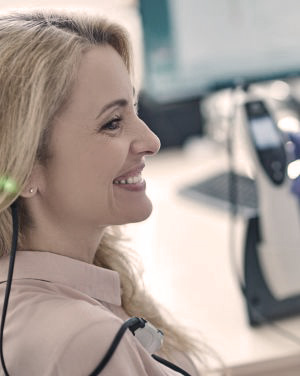

Auditory Brainstem Response
Auditory Brainstem Response (ABR) is one of the objective hearing tests, in which responses to sound stimuli are collected by a measuring device. This test records the electrical activity that propagates along the auditory pathways, from the auditory nerve to the auditory areas of the brain, in response to auditory stimuli. These signals are collected using electrodes placed on the forehead and mastoids, and sometimes on the scalp.
In clinical practice, Auditory Brainstem Response, which explore the auditory nerve and auditory pathways of the brainstem are useful for :
- Screening for deafness in infants and children.
- In the search for retrocochlear auditory damage (auditory nerve neuroma).
- Screening for Auditory Neuropathy Spectrum Disorders in children and adults, when subjective hearing tests show a discrepancy between tonal audiometry and speech audiometry, which measures intelligibility. ABR is then combined with acoustic Otoacoustic Emission.


The different types of Auditory Evoked Potentials
In practice, short-latency evoked potentials (ABR) are used to measure thresholds, wave amplitudes and differences between different waves.
ASSRs (Auditory Steady-State Response) deserve special mention because they allow the objective assessment of auditory thresholds over a wide frequency range to the nearest 10-15 dB HL.
Medium- and long-frequency auditory evoked potentials are mainly used to assess higher cognitive processes, such as music perception, auditory memory and emotion recognition. They are not commonly used.
Like all investigations aimed at assessing a patient’s hearing, this test is only of value if it is part of a comprehensive assessment of the auditory system, which includes a thorough anamnesis, microscopic otoscopy and subjective hearing tests (tonal and vocal audiometry).
